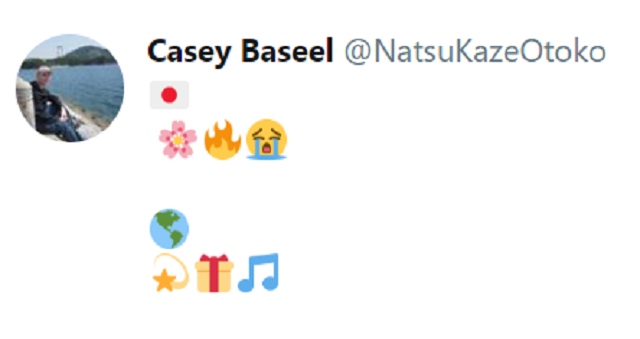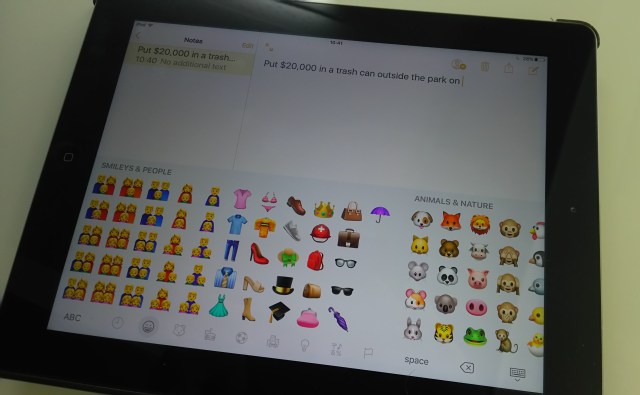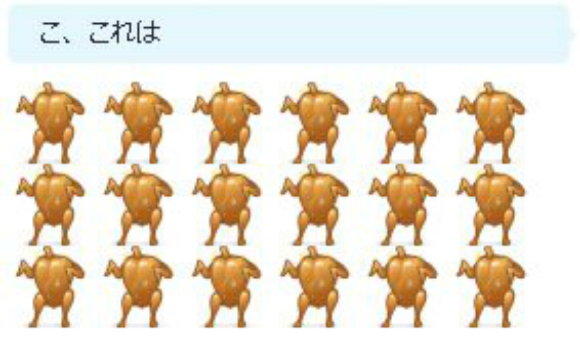emoji
Typing this Japanese word into your iPhone or Android device will introduce you to some very unusual characters.
The beloved anime magical girl is helping flowers bloom on social media.
It’s not fire, and it’s not food, but every Japanese person immediately understands the symbol that has the rest of the world scratching their heads.
Common sense might lead you to believe that “emoji” is simply a variation of “emoticon,” but Japanese common sense tells a whole different story.
You likely know that emoji originated in Japan, but do you know how they ended up basically everywhere in the world?
In Japan, you don’t “like” something on Facebook, you “ii ne” it. But what about the five other “reactions” that Facebook has just added?
Japanese netizens are both creeped out and confused by this new Thanksgiving/Christmas emoji from Skype.
When Japanese Twitter user @nasuiro posted this picture of a blob of hand cream last week, he probably had no idea that it would end up being retweeted over 41,000 times…
Oxford Dictionaries, the online arm of the publisher of the Oxford Dictionary of English, has announced that its 2015 Word of the Year is an emoji. No, not the word “emoji,” but a single, specific emoji.
Recently, with elements of the Japanese language and its culture starting to be adopted by people in countries the world over, we hear the word “emoji” being used incredibly often overseas. In fact, both the word “emoji” and the digital images themselves have become pretty much universal.
And now, those emoji that I knew from my cell phone screen here in Japan have even been turned into fashion icons!
In Part 1 of this article, we learned some fun facts about three iconic foods so beloved by the Japanese that they, yup, became icons—how an old lady and a samurai gave birth to the first rice cracker; what it means to be called a pudding-head in Japan; and how a classic 1960s manga cemented the way oden would be illustrated for decades to come.
So get ready for Part 2, in which I’ll attempt to sift through millennia of history and get you further acquainted with three more emoticons!
First we’ll look at the mythical tengu, a complex, multifaceted creature that in modern times pops up in things like Digimon and the Mega Man series. Then we’ll check out a New Year’s decoration that may have originated from taketaba, a shield made from bundled bamboo that became necessary once firearms were introduced. To close, we’ll explore the customs and lore surrounding the Tanabata festival, including the romantic legend of Orihime and Hikoboshi, who are both star-crossed lovers and actual stars in the sky.
LINE is a free instant-messaging and voice-call application that’s almost a necessity in Asia; for many, it’s cheaper than texting through their mobile plan, and the app’s astounding collection of oversized emoticons called stickers and sticons (short for sticker emoticons) makes chatting with your friends that much more fun and cute! However, Japanese users recently noticed a puzzling sticon that had found its way into the pool. The image, which we’ll be looking at later, is based on a worldwide fad that didn’t seem to catch on in Japan, so it’s no wonder that people were confused.
This prompted me to wonder, “Which emoji are gathering dust because some people don’t quite know what they are or what they mean?” Since emoji (literally meaning “pictographs”) originated in Japan and later became incorporated into Unicode, it makes sense that many are emblematic of that country’s culture. After asking a few friends, choices were narrowed down to the above six emoticons, available on most smartphones. In Part 1 we’ll be examining the three food-based emoticons, so if you’re not familiar with that geometry lesson on a stick or the origins of that brown circle, read on after the jump!
Sometimes words just aren’t enough to convey what you have to say.
People tend to use emoji in both normal and unorthodox ways, and the emoji you use actually says a lot about you.
Enter Emojinalysis, a Tumblr blog that tells you what’s wrong with your life based on your recently used emoji.


















 10 times to avoid traveling in Japan in 2026
10 times to avoid traveling in Japan in 2026 Umamusume anime girl plushie recalled for having parts she absolutely should not have【Pics】
Umamusume anime girl plushie recalled for having parts she absolutely should not have【Pics】 Ramen restaurant’s English menu prices are nearly double its Japanese ones, denies discriminating
Ramen restaurant’s English menu prices are nearly double its Japanese ones, denies discriminating Our 52-year-old pole dancing reporter shares his tips for achieving your New Year’s exercise goal
Our 52-year-old pole dancing reporter shares his tips for achieving your New Year’s exercise goal We ate sushi made from Japan’s most expensive tuna ever【Taste test】
We ate sushi made from Japan’s most expensive tuna ever【Taste test】 Japan’s Valentine’s Day gets extra cute with the return of KitKat Heartful Bear【Photos】
Japan’s Valentine’s Day gets extra cute with the return of KitKat Heartful Bear【Photos】 What’s inside the McDonald’s Japan fukubukuro lucky bag for 2026?
What’s inside the McDonald’s Japan fukubukuro lucky bag for 2026? Survey says osechi New Year’s food differs according to each region in Japan
Survey says osechi New Year’s food differs according to each region in Japan Four Shinto shrines to pray for love at in Japan to start the New Year
Four Shinto shrines to pray for love at in Japan to start the New Year Dragon Quest Burgers and Slime drinks are coming to McDonald’s Japan【Video】
Dragon Quest Burgers and Slime drinks are coming to McDonald’s Japan【Video】 Japanese beef bowl chain Sukiya’s 2026 Smile Box lucky bag basically pays for itself
Japanese beef bowl chain Sukiya’s 2026 Smile Box lucky bag basically pays for itself Hayao Miyazaki says Happy New Year to Studio Ghibli fans with new art for Year of the Horse
Hayao Miyazaki says Happy New Year to Studio Ghibli fans with new art for Year of the Horse Starbucks Japan ready to get Year of the Horse started with adorable drinkware and plushies【Pics】
Starbucks Japan ready to get Year of the Horse started with adorable drinkware and plushies【Pics】 Top Japanese cosplayer Enako returns to Comiket after 6 years, creates mayhem with admirers
Top Japanese cosplayer Enako returns to Comiket after 6 years, creates mayhem with admirers Cup Noodle tries an authentic Jiro-style ramen, but something’s not quite right
Cup Noodle tries an authentic Jiro-style ramen, but something’s not quite right The best Starbucks Japan Frappuccinos we want to drink again in 2026
The best Starbucks Japan Frappuccinos we want to drink again in 2026 We revisited Sweets Paradise after a decade to see if Japan’s dessert buffet still delivers
We revisited Sweets Paradise after a decade to see if Japan’s dessert buffet still delivers That time Seiji called JASRAC to ask why he didn’t get paid royalties for his song being on TV
That time Seiji called JASRAC to ask why he didn’t get paid royalties for his song being on TV 7-Eleven Japan starts new temporary luggage storage service in over 300 branches
7-Eleven Japan starts new temporary luggage storage service in over 300 branches Disillusionment at Tsukiji’s tourist-target prices led us to a great ramen restaurant in Tokyo
Disillusionment at Tsukiji’s tourist-target prices led us to a great ramen restaurant in Tokyo Starbucks teams up with 166-year-old Kyoto doll maker for Year of the Horse decorations【Photos】
Starbucks teams up with 166-year-old Kyoto doll maker for Year of the Horse decorations【Photos】 Tokyo considering law requiring more trash cans following litter increase in heavily touristed area
Tokyo considering law requiring more trash cans following litter increase in heavily touristed area Tokyo’s Tsukiji sushi neighborhood asks tour groups to stay away for the rest of the month
Tokyo’s Tsukiji sushi neighborhood asks tour groups to stay away for the rest of the month Tokyo event lets you travel back in time, for free, to celebrate 100 years since Showa era start
Tokyo event lets you travel back in time, for free, to celebrate 100 years since Showa era start Japan may add Japanese language proficiency, lifestyle classes to permanent foreign resident requirements
Japan may add Japanese language proficiency, lifestyle classes to permanent foreign resident requirements Lacquerware supplier to emperor of Japan and Pokémon team up for new tableware
Lacquerware supplier to emperor of Japan and Pokémon team up for new tableware Starbucks Japan releases new zodiac chilled cup drink for 2026
Starbucks Japan releases new zodiac chilled cup drink for 2026 Survey asks foreign tourists what bothered them in Japan, more than half gave same answer
Survey asks foreign tourists what bothered them in Japan, more than half gave same answer Japan’s human washing machines will go on sale to general public, demos to be held in Tokyo
Japan’s human washing machines will go on sale to general public, demos to be held in Tokyo We deeply regret going into this tunnel on our walk in the mountains of Japan
We deeply regret going into this tunnel on our walk in the mountains of Japan Studio Ghibli releases Kodama forest spirits from Princess Mononoke to light up your home
Studio Ghibli releases Kodama forest spirits from Princess Mononoke to light up your home Major Japanese hotel chain says reservations via overseas booking sites may not be valid
Major Japanese hotel chain says reservations via overseas booking sites may not be valid Put sesame oil in your coffee? Japanese maker says it’s the best way to start your day【Taste test】
Put sesame oil in your coffee? Japanese maker says it’s the best way to start your day【Taste test】 No more using real katana for tourism activities, Japan’s National Police Agency says
No more using real katana for tourism activities, Japan’s National Police Agency says Starbucks Japan reveals new sakura drinkware collection, inspired by evening cherry blossoms
Starbucks Japan reveals new sakura drinkware collection, inspired by evening cherry blossoms Updated cherry blossom forecast shows extra-long sakura season for Japan this year
Updated cherry blossom forecast shows extra-long sakura season for Japan this year Human washing machine pods coming to Japanese hotels【Photos】
Human washing machine pods coming to Japanese hotels【Photos】 Japan’s Valentine’s Day gets extra cute with the return of KitKat Heartful Bear【Photos】
Japan’s Valentine’s Day gets extra cute with the return of KitKat Heartful Bear【Photos】 What’s inside the McDonald’s Japan fukubukuro lucky bag for 2026?
What’s inside the McDonald’s Japan fukubukuro lucky bag for 2026? Survey says osechi New Year’s food differs according to each region in Japan
Survey says osechi New Year’s food differs according to each region in Japan Four Shinto shrines to pray for love at in Japan to start the New Year
Four Shinto shrines to pray for love at in Japan to start the New Year Dragon Quest Burgers and Slime drinks are coming to McDonald’s Japan【Video】
Dragon Quest Burgers and Slime drinks are coming to McDonald’s Japan【Video】 “The best curry I’ve ever had in my life, ever” comes from a Tokyo curry vending machine
“The best curry I’ve ever had in my life, ever” comes from a Tokyo curry vending machine Final Fantasy and Shinkansen announce collaboration with in-train audio play, SD art and merch
Final Fantasy and Shinkansen announce collaboration with in-train audio play, SD art and merch The mystery of the phantom “sake pass card” at Japanese alcohol vending machines
The mystery of the phantom “sake pass card” at Japanese alcohol vending machines Top Japanese cosplayer Enako returns to Comiket after 6 years, creates mayhem with admirers
Top Japanese cosplayer Enako returns to Comiket after 6 years, creates mayhem with admirers The awesome independent-creator, one-day-only anime figures of summer Wonder Festival【Photos】
The awesome independent-creator, one-day-only anime figures of summer Wonder Festival【Photos】 Ramen vending machine brings a new noodle stand experience to Tokyo station
Ramen vending machine brings a new noodle stand experience to Tokyo station Majority of Japanese mayors say foreign residents are essential but most see good and bad effects
Majority of Japanese mayors say foreign residents are essential but most see good and bad effects